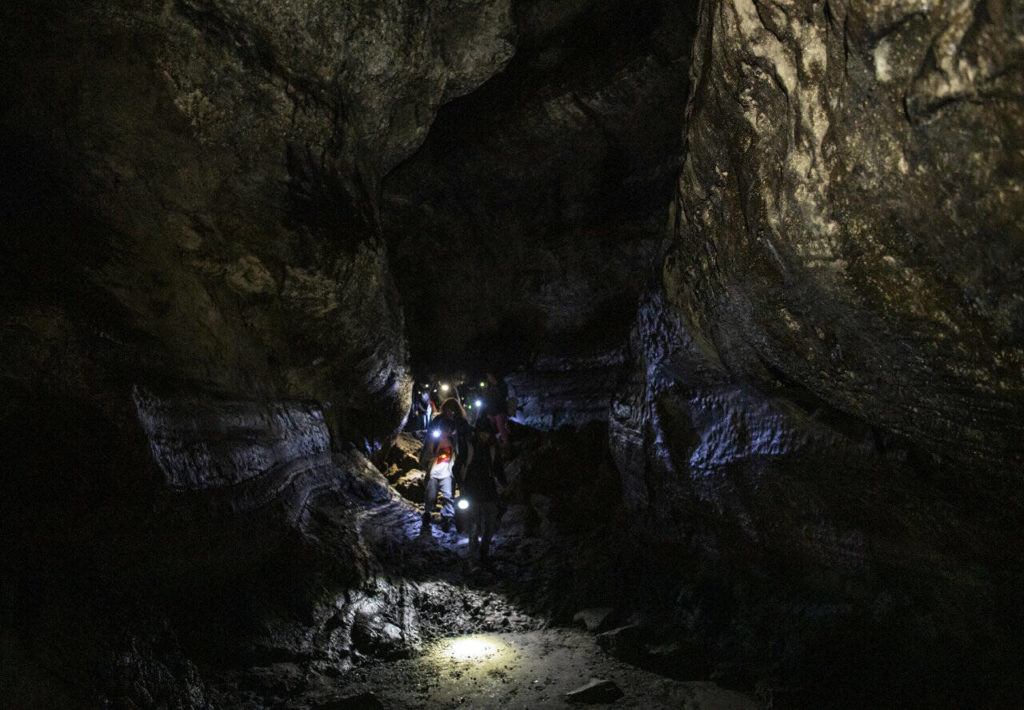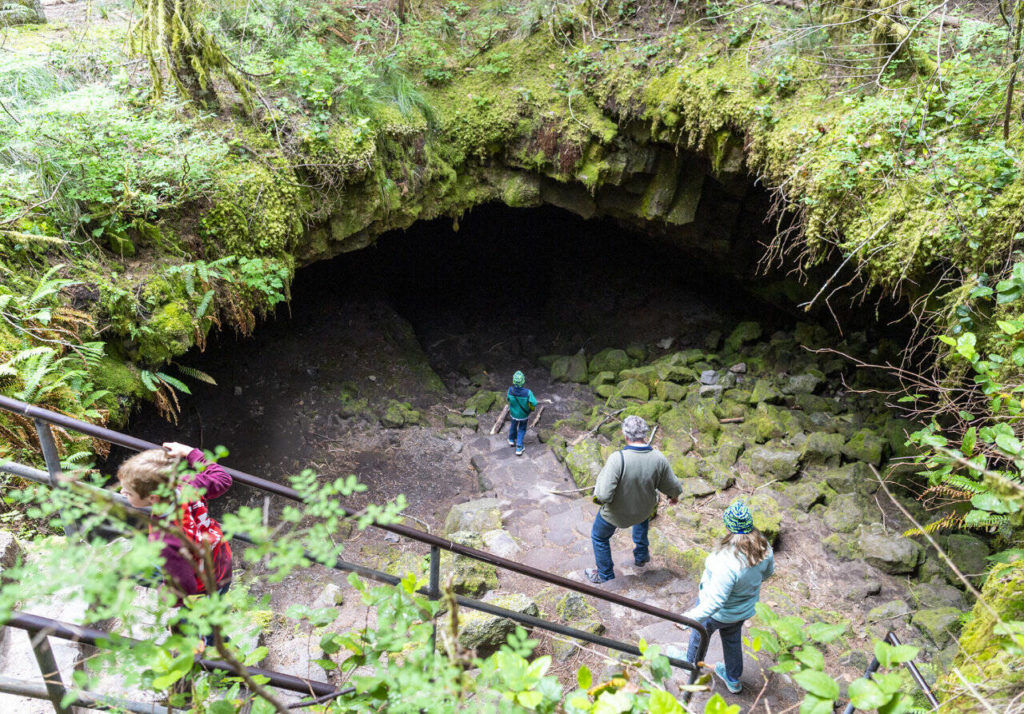By Scott Hewitt / The Columbian
COUGAR — A bit sizzly up there on the surface, is it? Why not hang out down here, underground, with us supremely cool apes?
The year-round temperature inside Ape Cave, a lava tube on the southern approach to Mount St. Helens in southwest Washington, is a stable 42 degrees no matter the weather outside. That’s cold enough to see your breath, if you can see anything at all. Which you can’t down here, not without your own light.
Darkness and chill are the central features of any visit to Ape Cave. This isn’t the kind of outing that offers big vistas and information stations, other than on the surface before you descend. Once you’re underground, exploring Ape Cave really means exploring your own tolerance for shadows, cold and overall creepiness.
Sounds like fun, doesn’t it? It sure is, in a spooky sort of way. Just ask the army of intrepid summer-camp kids from Friendly House in Portland who were marching through the cave, armed with flashlights and headlamps, when The Columbian visited one morning in late July.
Lamps and lanterns
Ease yourself down the long metal staircases that descend into an enormous but well-hidden pit in the forest. Step carefully over the rubble strewn around this bubble of light, which turns out to be soberingly small.
This is where you realize that the U.S. Forest Service’s recommendation of two light sources per person is no joke. Standard cellphone lights that seem obnoxiously bright above ground are swallowed whole in this darkness.
Your spelunking Columbian correspondents wore strap-on headlamps and carried bright camping lanterns. The latter did most of the work. During summer you can rent lanterns at the visitor booth here ($5 in cash or $5.39 by card).
Take a breath. Face the unknown. Feel the cold start to settle in. That’s mostly the ambient temperature down here — unless it’s also the tiniest thrill of fear.
This way, a sign says, is the lower cave: a ¾-mile tunnel that’s not especially challenging nor tight enough to trigger claustrophobic willies. It takes about an hour to go out and back for a 1½-mile journey in all.
The other way is the upper cave: a rugged 1½ miles up a tighter, twistier corridor that demands careful stepping, scrambling over rocks and caution about banging your head. Budget yourself at least two hours to explore the upper cave, after which you clamber up a metal ladder and make your way back along a surface trail that’s part forest oasis and part pahoehoe museum.
Crust and flow
Pahoehoe is that blobby, undulating lava that looks exactly like what it is: hardened liquid. It’s a Hawaiian term for the shapely lava you’ll find on the islands, a type less often found in the Cascade Range.
Almost 2,000 years ago, oozy, slow-moving basalt lava trickled out of a vent on the south side of Mount St. Helens. Pahoehoe forms a hard crust that preserves its inner heat, allowing it to travel long distances. At Ape Cave, a tight pahoehoe seal formed on the forest floor while lava kept flowing below, carving a unique 2-mile-long tube that was eventually left empty as the lava trickled away again.
The terraced walls of Ape Cave reveal how that happened unevenly, in waves, with different layers and well-formed lava shelves distinctly visible. As the lava sank away, super-hot gases baked the tunnel walls into a shiny, intricately textured glaze.
As you travel, the crust of lava overhead can vary in height from as low as a basement ceiling to as tall as a cathedral. The carpet of sand and ash underfoot in the lower cave was deposited during relatively recent volcanic ash flows.
Any fragile, removable geologic formations, including stalagmites, were carted away by tourists long ago. The oddball formation near the bottom of the lower cave that’s still here is the glob of cooled lava that apparently fell from the ceiling, floated down the lava stream and became wedged in a narrow spot just over your head. It’s called The Meatball.
Apes, bats, slime
According to the U.S. Forest Service, the yawning mouth of Ape Cave was discovered in 1947 by Lawrence Johnson, a logger from nearby Amboy. But it was local Scout leader Harry Reese who had the clever idea of letting his troop of eager young Boy Scouts do the initial exploring.
They didn’t find apes. According to the Forest Service, Ape Cave’s name comes from the Scouts’ sponsorship organization, the St. Helens Apes, a group of local outdoorsmen. It’s unknown whether the St. Helens Apes were playing with the term “brush ape,” slang for hillbilly, or adopting local legend Sasquatch as their mascot.
What Ape Cave does have by way of inhabitants is insects, salamanders, mice and bats. A boot-brush station is provided near the mouth of Ape Cave so visitors can clean off any hitchhiking fungal spores that cause white-nose syndrome, which is deadly to bats and spreading in Washington.
There isn’t much by way of plant life down in the darkness of Ape Cave except for lichen, moss and a nutrient-rich goo that insects feast upon called cave slime. When you visit Ape Cave, please don’t touch the slime.
Tickets and parking
Ape Cave is a 4½-hour drive from Everett.
A popular tourist destination, Ape Cave manages crowds through timed ticketing and parking permits May through October.
Make your timed reservation (two-hour window) at tinyurl.com/EDH-ape-cave. Price: $2.
To park at Ape Cave, purchase a Northwest Forest Pass onsite or online at tinyurl.com/EDH-GP-passes. Price: $5 per day, $30 for one year. (A Northwest Forest Pass gets you admission to all Forest Service recreation sites in Washington and Oregon.)
Talk to us
> Give us your news tips.
> Send us a letter to the editor.
> More Herald contact information.



























